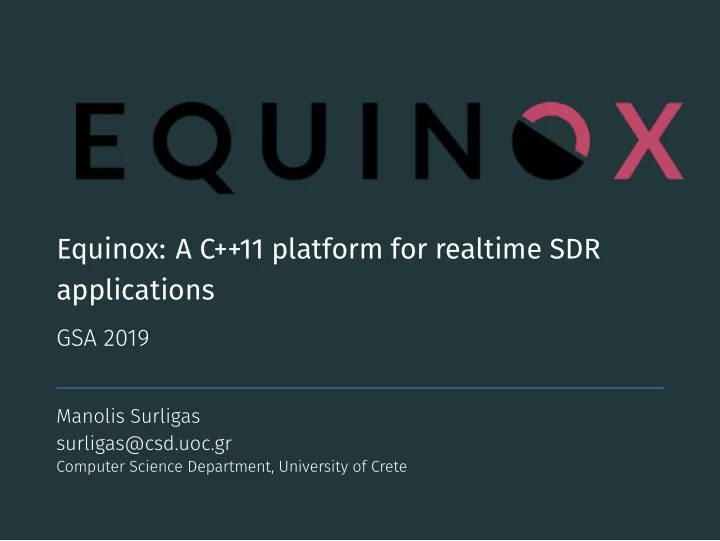

Equinox: A C++11 platform for realtime SDR applications Equinox: A C++11 platform for realtime SDR applications GSA 2019 Manolis Surligas surligas@csd.uoc.gr Computer Science Department, University of Crete
Equinox • Equinox is a C++11 based SDR platform • Based on message passing rather than streaming Goals • Extendable via plugins • Adapt to application requirements • Provide a Visual Programming language • Proper handling of bursty transmissions • Reduce latency 1
Equinox Why C++11? • Modern, fast, complete • Range based loops • Shared pointers • Integrated threading library • Bye-bye Boost!!! 2
Architecture 3 Equinox Core Kernels GUI Memory Management QT5 Math Graph analysis DSP Filtering Scheduling FFT Load balancing etc
Qt5 UI 4
Memory Management • NO dynamic memory allocation 5 • Each output port holds a memory pool • Memory pools with pre-allocated memory Mem Pool 1 Mem Pool 0 Msg 3 Msg 2 Msg 1 Msg 22 Msg 0 Kernel 0 Msg 21 Msg 20 Kernel 1 Kernel 2
Memory Management • Kernels exchange messages of fixed size • Each message is a std::shared_ptr pointer to a memory location at the memory pool • Each output port is a message queue holding message pointers • No memory copy, just pass the pointers (Zero-Copy) • Automatic garbage collection, through the std::shared_ptr based messages 6
Equinox: Graph analysis & Load balancing • Platforms like GNU Radio, follow a one-thread-per-block approach • This is fine, as soon as the number of blocks is small • Modern telecommunications systems require a large number of processing tasks • E.g IEEE 802.11 transceiver has about 40 blocks • Thread synchronization, preemption and cache misses overhead starts to exceed the actual computation 7
Graph analysis & Load balancing • Equinox tries to balance these overheads • Use minimum number of threads • Exploit graph topology • Assign effjciently the processing tasks into the available worker threads 8
Graph analysis & Load balancing workers to avoid indirect data dependencies • The first task is to identify the connected components of 9 • Difgerent components should be assigned to difgerent the graph • Use a slightly altered version of the DFS Worker 1 Worker 1 Kernel A Kernel B Kernel C Kernel A Kernel B Kernel C Kernel M Kernel N Kernel M Kernel N Worker 0 Worker 0
Graph analysis & Load balancing • Then split the graph into N sub-graphs, where N is the number of workers • Equinox provides difgerent ways to split the graph • The most interesting is the spectral method • Split the graph based on the eigenvalues of the adjacency matrix • Minimizes the connections between sub-graphs 10
Other applications? Is Equinox only for SDR applications? • Audio processing • Video processing • Network applications • Packet tagging • Filtering • DPI 11 • Handle frames as messages �
Join the party! https://gitlab.com/equinox-sdr/equinox 11
Questions? 11
Recommend
More recommend